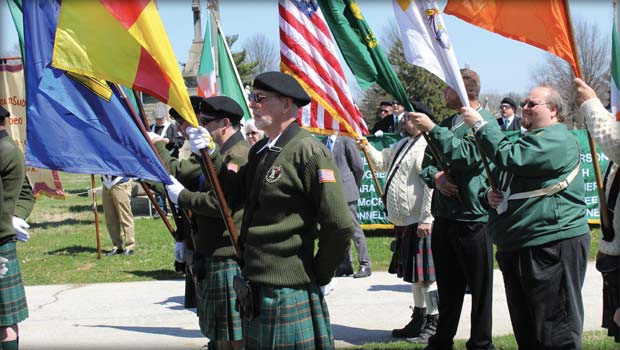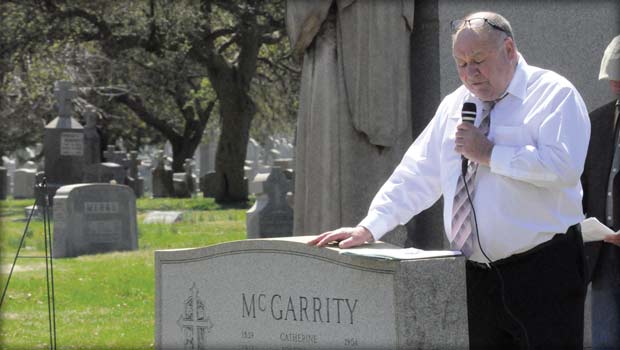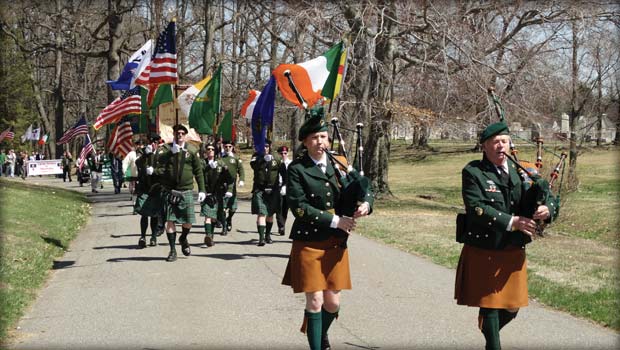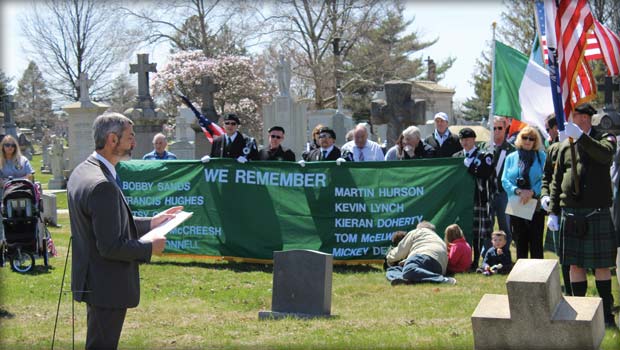Above: AOH Div. 25 Honor Guard. Photo – Tom Keenan
By Msgr. Francis A. Carbine
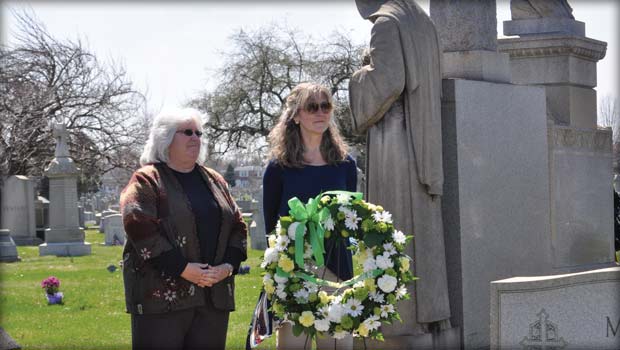
Regina Bocchino and Deirdre Mullin, granddaughters of Joseph McGarrity at the ceremony. Photo – Tom Keenan
The weather was post-card perfect. Forsythia and magnolia flowers fulfilled expectations. Ornamental trees sported buds alive with promise. The breeze was tailored to the colorful flags, and the sun never shone more brightly on “the wearing of the green.”
The occasion was the event held in Holy Cross Cemetery, Yeadon, on Sunday the 12th of April, 2015, to memorialize the active loyalty to Ireland by Luke Dillon [d.1930] and Joseph McGarrity [d.1940]. Both men were interred in Holy Cross. The day also celebrated the spirit of the Easter Rising, Dublin, 1916.
Marching behind the honor guard and twenty flags – American, Papal, Irish, Provinces of Ireland, Irish Counties and Societies – was John Flood, born in Gartan, County Donegal, and resident in Upper Darby.
He called Dillon and McGarrity “inspirational heroes whose dedication and tenacity should inspire all people – especially those living under the ‘cosh’ – the black stick or billy club!” John added, “While self praise is no good, I am a bit of an historian myself!”
Connell McCrea, Warminster, said that “Dillon and McGarrity are heroes who gave us a legacy of peace.” Connell has been involved in Irish causes for 30 years.
Two members of the Color Guard were Ryan Dougherty, 15 years of age, and Matt Cantz, 27. Both belong to the American Legion Color Guard, and were assisting the AOH for this annual occasion. Both live in Northeast Philadelphia.
Mike Mahon from Fox Chase – with grandparents from Galway and Donegal – said that Dillon and McGarrity were like “David battling Goliath.”
“In time past, the Irish were treated as second class citizens in their own country. These two men showed that the ‘little guy’ has a chance to go against the establishment. Get enough ‘little guys’ together and you have a ‘big guy!’”
Among the banners was one proclaiming: “We Remember” and listing the names of Bobby Sands and eight other Hunger Strikers who died in 1981. Other banners identified the Loughgall Martyrs Club, Tyrone Society, MacSweeney Club, and Clan Na Gael.
Connie McMahon recently returned from Dublin where she toured Dublin’s Post Office and Kilmainham Jail. She and her son Matt were first time visitors to the event at Holy Cross. Matt noted that his participation strengthened his faith in his Irish heritage.
Many in the crowd of several hundred wore T-shirts with text: “We declare the right of the people of Ireland to the ownership of Ireland.” Words come from the Easter Proclamation, 1916. This date launched modern Irish independence.
The marchers headed first to the tombstone of Luke Dillon where Deacon Paul J. McBlain, St. Joseph parish in Collingdale, prayed the Invocation. He remembered the “deeds and gifts” of many persons, “to secure for our ancient land and race, that freedom and opportunity which should be hers by justice and right.”
Jacqueline Dillon Burns, a direct descendant of Luke Dillon, said that her ancestor was “a gentleman who never set foot in Ireland, but had a deep understanding of what the Irish endured.” Dillon was born in England.
After a three-gun salute, green kilted pipers led the way to the stone of Irish-born Joseph McGarrity. Here they played “Wrap the Green Flag Around Me, Boys.” The extensive McGarrity papers are at Villanova University. His granddaughters presented flowers.
Persons who addressed the gathering included Sean Conlon, Sinn Fein councilor, County Monaghan; Mike Moran, descendant of Luke Dillon; and Patsy Kelly, member of Northern Aid. A shared theme was a “Free and United Ireland.”
Important in organizing the 2015 event is Robert Dougherty. “I attended my first McGarrity commemoration in the early ’80’s. I have also served as director of the Irish political prisoners children’s holiday program. At present, I am chairman of a group that provides assistance to Republican prisoners and their families.
After Sean Conlon read the Easter Proclamation, he noted, “the struggle won’t be over until we achieve a united Ireland.” His sympathetic audience well understood his phrase: “the unfinished business of 1916!”

